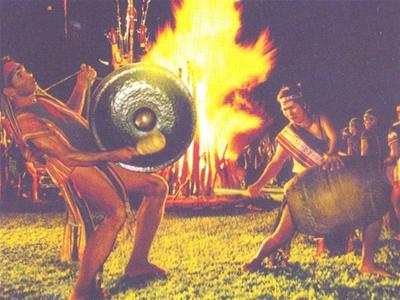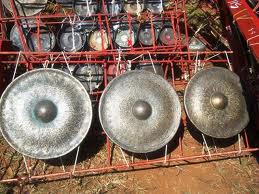
THE SPACE OF GONG CULTURE IN CENTRAL HIGHLANDS
The gongs are made of brass alloy or a mixture of brass and gold, silver, bronze. Their diameter is from 20cm to 60cm or from 90cm to 120cm. A set of gongs consists of 2 to 12 or 13 units and even to 18 or 20 units in some places.
The space of gong culture in Central Highlands of Viet Nam covers 5 provinces of Kon Tum, Gia Lai, Dak Lak, Dak Nong and Lam Dong. The masters of gong culture are the ethnic groups of Ba Na, Xo Dang, M’Nong, Co Ho, Ro Mam, E De, Gia Rai… The gong performances are always closely tied to community cultural rituals and ceremonies of the ethnic groups in Central Highlands. Many researchers have classified gongs as ceremonial musical instrument and the gong sounds as a means to communicate with deities and gods.
The gongs are made of brass alloy or a mixture of brass and gold, silver, bronze. Their diameter is from 20cm to 60cm or from  90cm to 120cm. A set of gongs consists of 2 to 12 or 13 units and even to 18 or 20 units in some places.
90cm to 120cm. A set of gongs consists of 2 to 12 or 13 units and even to 18 or 20 units in some places.
In most of ethnic groups, namely Gia Rai, Ede Kpah, Ba Na, Xo Dang, Brau, Co Ho, etc., only males are allowed to play gongs. However, in others such as Ma and M’Nong groups, both males and females can play gongs. Few ethnic groups (for example, E De Bih), gongs are performed by women only.
As for the majority of ethnic groups in Central Highlands, gongs are musical instruments of sacred power. It is believed that every gong is the settlement of a god who gets more powerful as the gong is older. "God of gong" is always considered as the tutelary deity for the community’s life. Therefore, gongs are associated to all rites in one’s life, such as the inauguration of new houses, funerals, buffalo sacrifice, crop praying rite, new harvest, ceremony to pray for people’s and cattle’s health, ceremony to see-off soldiers to the front, and the victory celebration.
In Central Highlands, gongs are often performed in the form of orchestra. Gong orchestras adopt a natural sound-scale as the foundation for theirs. Depending on different ethnic groups, a gong orchestra can consist of 3, 5 or 6 primary sounds. However, as a polyphonic musical instrument, gongs often have some additional sounds apart from their basic ones. In fact, a six-gong orchestra can produce more or less 12 different sounds. So, gong sounds are heard resonant and solid. Moreover, a gong orchestra is arranged in a broad space, so the melody is formed by three-dimensional sounds with different pitch, length and resonance. It is the stereophonic effect - an original phenomenon of gong performance.
The space of gong culture in Central Highlands are heritage with temporal and spatial imprints. Through its categories, sound- amplifying method, sound scale and gamut, tunes and performance art, we will have an insight in a complicated art developing from simple to complexity, from single to multi-channel. It contains different historical layers of the development of music since the primitive period. All artistic values have the relationships of similarities and dissimilarities, bringing about their regional identities. With its diversity and originality, it’s possible to confirm that gongs hold a special status in Viet Nam’s traditional music.
amplifying method, sound scale and gamut, tunes and performance art, we will have an insight in a complicated art developing from simple to complexity, from single to multi-channel. It contains different historical layers of the development of music since the primitive period. All artistic values have the relationships of similarities and dissimilarities, bringing about their regional identities. With its diversity and originality, it’s possible to confirm that gongs hold a special status in Viet Nam’s traditional music.
On November 25, 2005 in Paris, France, the space of gong culture in Central Highlands was recognized by UNESCO as an oral-transmitted masterpiece and intangible cultural heritage of the humanity
- CENTRAL SECTOR OF THE IMPERIAL CITADEL OF THANG LO
- QUAN HO BAC NINH FOLK SONGS
- MY SON SANCTUARY - WORLD CULTURAL HERITAGE
- CA TRU SINGING
- NHA NHAC, VIETNAMESE COURT MUSIC
- HOI AN ANCIENT TOWN - WORLD CULTURAL HERITAGE
- COMPLEX OF HUE MONUMENTS - WORLD CULTURAL HERITAGE
- HA LONG BAY - WORLD NATURAL HERITAGE


 Royal Gate
Royal Gate
 NIKKO HANOI
NIKKO HANOI
 Trade Union Hotel Hanoi (Congdoan hotel)
Trade Union Hotel Hanoi (Congdoan hotel)
.jpg) Cultural Hanoi
Cultural Hanoi
 North Vietnam Exclusive
North Vietnam Exclusive
 Attractive North
Attractive North
 Charming North
Charming North

